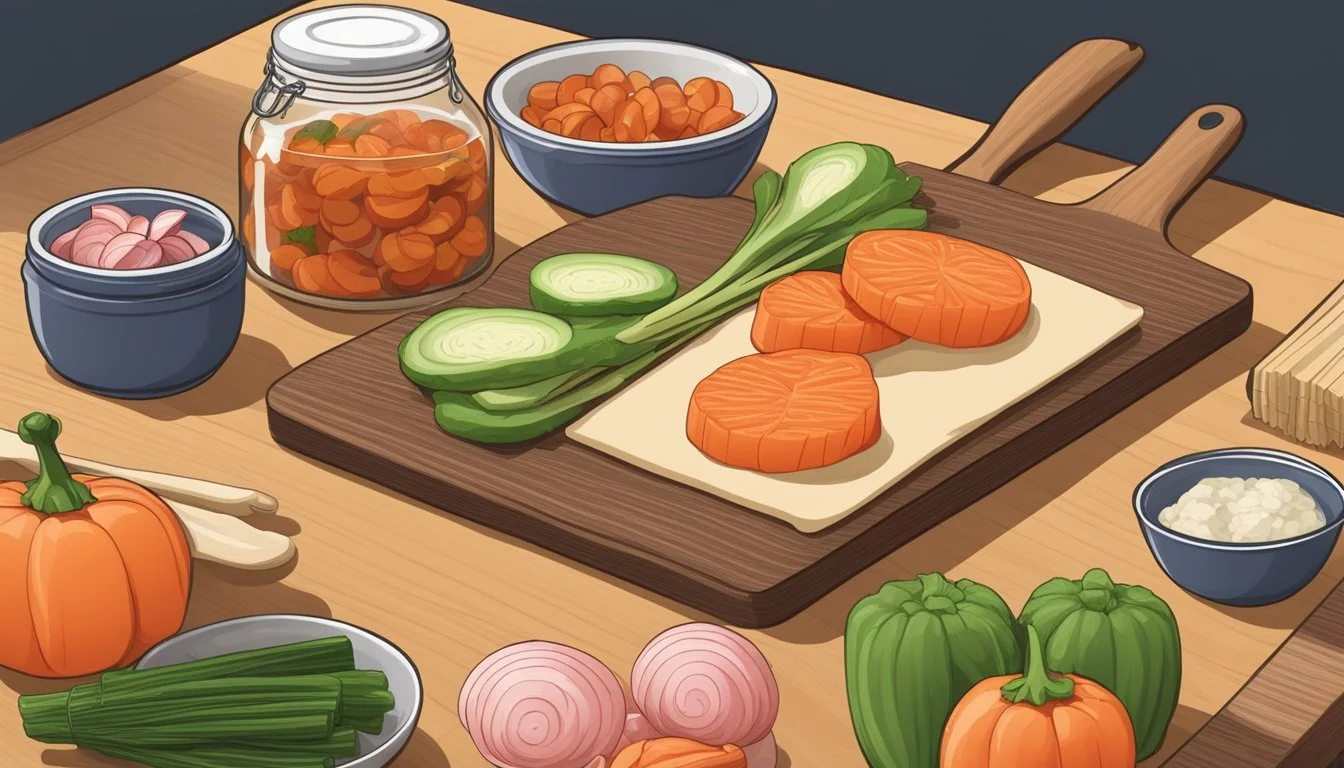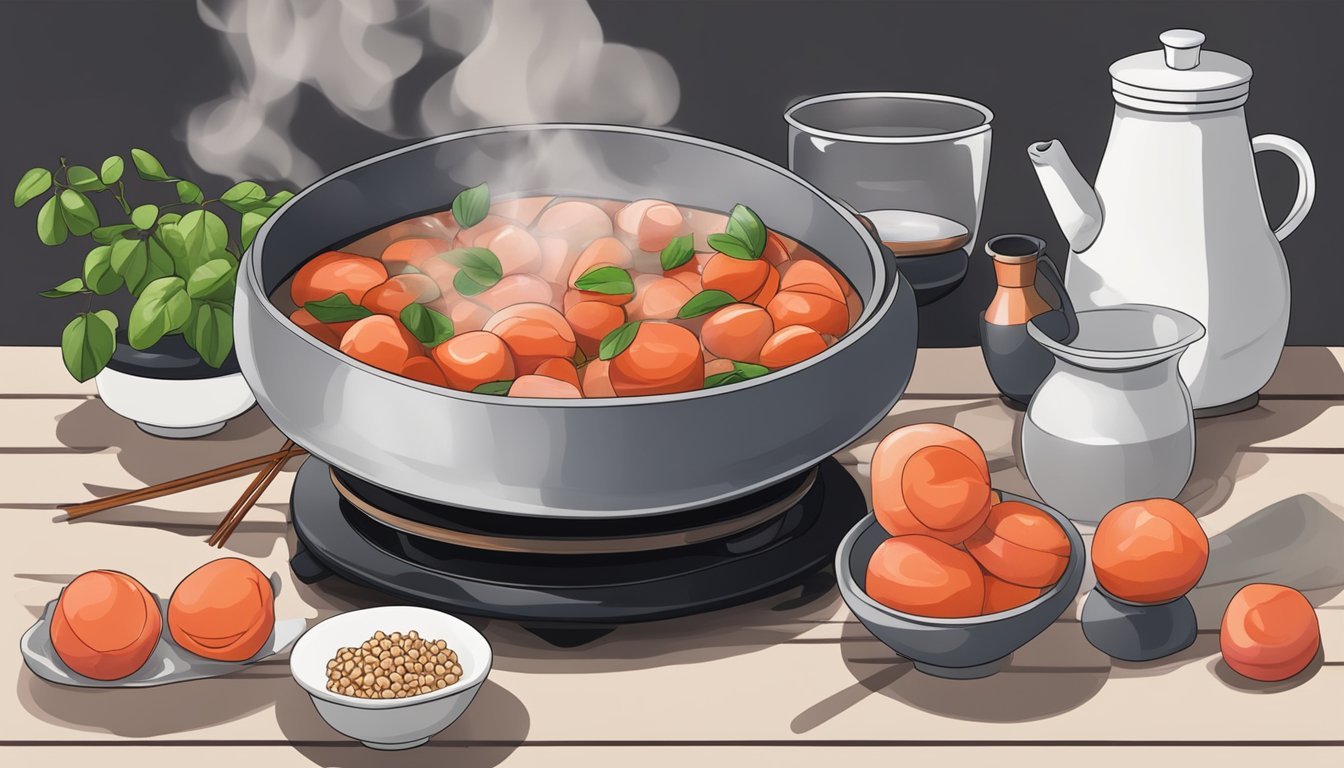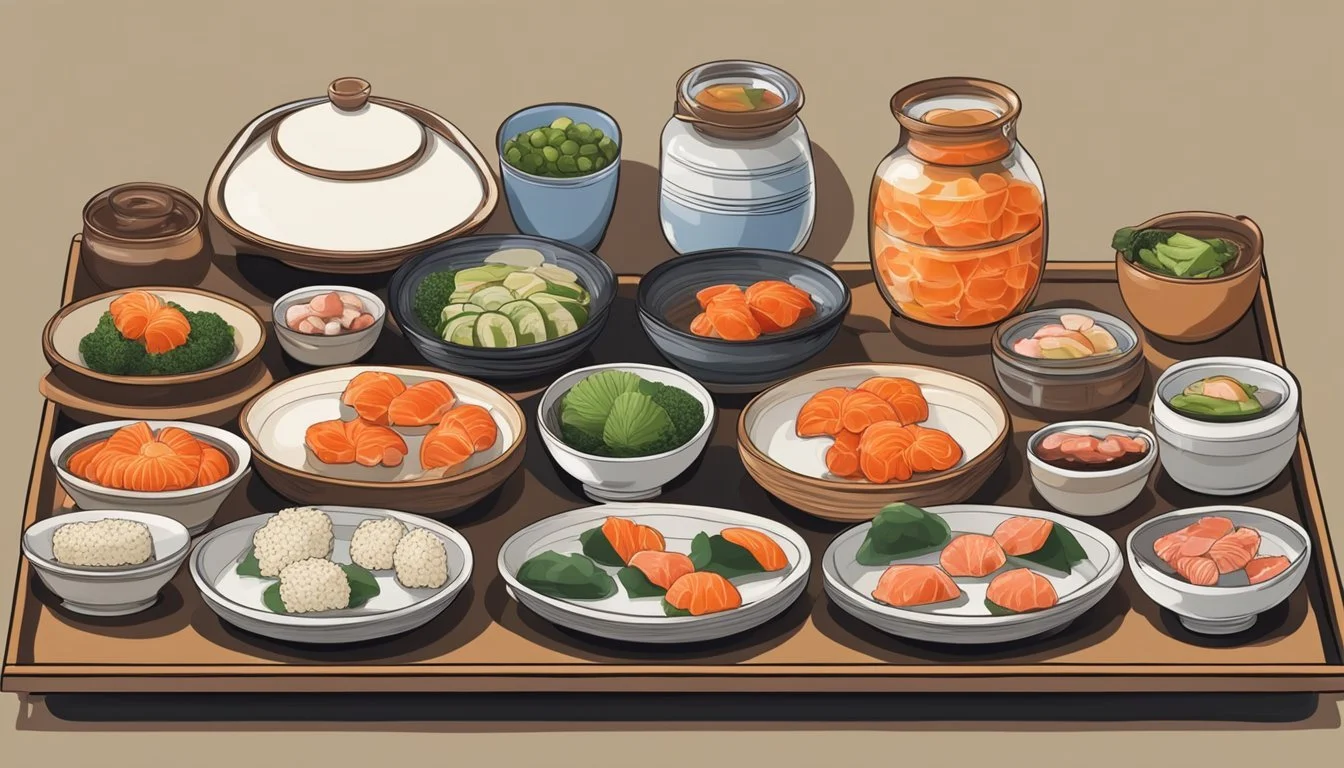How to Cook with Umeboshi
Mastering Japanese Pickled Delights
Umeboshi, which translates to "dried plum" in Japanese, is a culinary gem that has graced Japanese cuisine for centuries. These pickled plums are made from the ume fruit, a species related to the apricot, traditionally harvested in early summer. Their unique flavor profile—a combination of intense sourness and saltiness—makes them a versatile ingredient in Japanese cooking, capable of enhancing dishes with their distinct taste.
Integrating umeboshi into cooking can transform the most mundane meals into Japanese pickled delights. Umeboshi can be found in various forms such as whole pickled fruits, purees, or even as a seasoning paste. Its robust flavor is known to complement rice, add zest to sauces, and provide a balance to rich and savory dishes. Aside from its use in the culinary world, umeboshi is also valued for its potential health benefits including aiding digestion and contributing to overall wellness.
When cooking with umeboshi, it's important to consider its potency and the balance of flavors in a dish. Even though it might be tempting to use them liberally, a small amount often goes a long way. Whether it's wrapped in rice for onigiri, minced into dressings, or served with a steaming cup of green tea, umeboshi's ability to elevate a recipe while providing a taste of traditional Japanese cuisine is unrivaled.
History and Cultural Significance
Umeboshi, the pickled plum of Japan, has traversed centuries, infusing its sour, salty taste into the country’s cuisine and culture. From its ancient origins to its beloved presence in modern Japanese kitchens, umeboshi remains a culinary icon.
Origin of Umeboshi
The story of umeboshi begins in ancient China, where it was first made during the Tang Dynasty (618-907 AD). The technique of pickling plums was carried to Japan, where it was embraced widely due to the plentiful supply of ume plums. In the fertile region that comprises present-day Wakayama Prefecture, the art of umeboshi-making was perfected.
Umeboshi in Japanese Cuisine
Umeboshi plays a versatile role in Japanese cuisine, offering a unique balance of sour and salty flavors. It's a staple for rice balls, also known as onigiri, and is a key ingredient in the hinomaru bento, symbolizing the Japanese flag with its distinctive red color against white rice. Commonly, salt and red shiso are used to season umeboshi, with the shiso leaves contributing to the pink hue and a subtle minty flavor.
Cultural Practices and Umeboshi
In the realm of cultural practices, umeboshi is more than just a food item; it is a symbol of perseverance and good health. The pickled plum's association with longevity and well-being can be found in various traditional events where shiso-zuke umeboshi, with its fortifying aroma, is served. Moreover, the red color of the red shiso-colored plums is seen as auspicious, often gifted as a sign of good fortune.
Health Benefits and Nutritional Information
Umeboshi plums are not only a unique ingredient in Japanese cooking, but they are also celebrated for their nutritional properties and health benefits. Rich in essential nutrients and historically considered a Japanese superfood, these pickled plums are a valuable addition to any health-conscious kitchen.
Nutritional Components of Umeboshi
Umeboshi plums offer a rich source of several key nutrients. They are:
High in fiber, which aids in digestion and supports overall gut health.
A source of potassium, an essential mineral that helps in maintaining proper heart function and regulates blood pressure.
Nutrient Amount per 100 grams Calories 33 Carbohydrates 7.7 g Dietary Fiber 6.1 g Potassium 4 mg
Note: The exact nutritional content can vary depending on the preparation method and the specific product.
Health Benefits Associated with Umeboshi
Liver Health: The consumption of umeboshi is linked with liver health benefits. They contain compounds that may support liver function and promote detoxification.
Food Poisoning: Umeboshi plums have a long-standing reputation for helping to prevent and treat symptoms of food poisoning, thanks to their antibacterial properties.
General Well-Being: Consuming umeboshi may contribute to improved gastrointestinal health and enhanced immune function. These plums are believed to have alkalizing effects on the body, which can contribute to better health outcomes.
In summary, umeboshi plums are much more than a culinary ingredient; they're a nutritionally dense food that supports overall health.
Selecting and Preparing Umeboshi
When incorporating umeboshi in Japanese cooking, it's crucial to select the right type and ensure it's prepared properly for optimal flavor and longevity.
Types of Umeboshi
Umeboshi are pickled ume fruits, related to plums and apricots. They range from small and tart to larger and somewhat sweet. Homemade umeboshi often has a more natural and nuanced taste compared to commercially produced ones, which may contain added preservatives. The addition of red shiso leaves during the pickling process is common and gives umeboshi a distinct pink hue while also enhancing their flavor.
What to Look for When Buying Umeboshi
When purchasing umeboshi, one should look for:
Firmness: Umeboshi should be plump and firm to the touch.
Color: A natural reddish-pink hue, which indicates the presence of shiso leaves.
Ingredients: Short list of ingredients, ideally just ume plums, salt, and shiso leaves, suggests minimal processing.
Preservatives: Avoid products with high sodium content or unnecessary additives.
Preparation and Storage Tips
Prior to using umeboshi, they should be rinsed under cold water to remove excess salt. Storage is straightforward; umeboshi should be kept in a refrigerator, and if properly salted, they can last for years due to their natural fermentation. Salt not only flavors but also preserves the ume plum, preventing spoilage. If one has made homemade umeboshi, ensure they are stored in a clean, airtight container to maintain quality.
Cooking with Umeboshi
Umeboshi, the tart and salty Japanese pickled plums, bring a unique flavor to a variety of dishes. They are versatile and can be used to enhance the taste of both traditional Japanese and innovative fusion recipes.
Basic Techniques
When using umeboshi in the kitchen, one can start by integrating them into rice dishes. Cooking steamed rice with a whole umeboshi can subtly infuse it with a tangy flavor. Alternatively, umeboshi paste, easily made by removing the pit and mashing the flesh, can be stirred into Japanese short-grain rice for a punch of umami. For a quick, tasty treat, umeboshi can be placed inside onigiri, or rice balls, often wrapped with nori seaweed. This not only adds flavor but also acts as a natural preservative.
Umeboshi Pit Removal: Gently press on the umeboshi to extract the pit and use the flesh.
Making Umeboshi Paste: Mash the pitted umeboshi until it forms a paste, known as neri ume.
Umeboshi-based Recipes
Several traditional Japanese recipes incorporate umeboshi, such as Umeboshi Onigiri and Ume Ochazuke, where the plums are added to green tea poured over rice. Chazuke often includes toppings like sesame seeds, whereas onigiri can be simply made with umeboshi as the central filling or combined with other ingredients like salmon. Umeboshi pairs well with ingredients that have a mild taste, as they add a burst of bold flavor.
Umeboshi Onigiri: A classic rice ball with an umeboshi center, often wrapped in nori sheets.
Ume Ochazuke: Green tea over rice with umeboshi, sesame seeds, and sometimes nori or fish.
Fusion and Innovative Uses
Chefs can get creative by incorporating umeboshi into fusion dishes. The saltiness and acidity of umeboshi can cut through the richness of fried foods like tempura, offering a zesty counterbalance. Umeboshi can also be used as a condiment in vegan dishes due to its strong flavor profile that enhances without the use of animal products. A splash of plum vinegar, derived from umeboshi, adds dimension to vinaigrettes and sauces, bringing a touch of Japanese flavor to the table.
Fish: Serve umeboshi paste as a side to grilled or baked fish for an added flavor kick.
Tempura Dipping Sauce: Mix plum vinegar with soy sauce for a unique twist on tempura sauce.
Innovative Pairing: Pair umeboshi with noodles or use as a topping for salads to infuse a Japanese-inspired tang.
Serving and Presentation
The sharp tartness and iconic saltiness of umeboshi offer endless possibilities in Japanese cuisine, transforming simple dishes into complex flavor experiences.
How to Serve Umeboshi
Traditionally, umeboshi plums are a staple for rice seasoning. They are often served with a bowl of steamed rice or onigiri (rice balls) to enhance the flavor with their salty punch. Umeboshi cut into thin strips or diced can be sprinkled over the rice to distribute its distinctively sour taste evenly.
Rice: Place one umeboshi at the center of a bowl of hot rice or inside an onigiri.
Rice Seasoning: Chop or mince umeboshi to sprinkle over rice as a seasoning.
Incorporating Umeboshi in Bento Boxes
Umeboshi's preservative properties make it a perfect addition to bento boxes. Its bold flavor contrasts well with the subtlety of other bento components, acting as a palate cleanser.
Meat & Vegetables: Place whole or sliced umeboshi alongside meat or vegetable dishes in a bento to add a burst of flavor.
Green Tea: Pack dry umeboshi in a small container to be added to green tea for a salty, tangy drink.
Umeboshi as a Condiment
As a condiment, umeboshi plums or paste can be innovatively used to add complexity to dressings or paired with vegetables to create unique side dishes.
Dressings: Puree umeboshi into dressings for an acidic kick that balances creamy textures.
Vegetables: Toss blanched or steamed vegetables with diced umeboshi for a zesty side dish.
They can also be found as a puree or paste in Japanese supermarkets, offering a convenient way to incorporate the umeboshi flavor into recipes without the need to pit and chop the plums.
Umeboshi in the Digital Age
In the realm of culinary exploration, Umeboshi, Japanese pickled plums, have transcended traditional boundaries, making a notable impression in the digital world. This section explores how Umeboshi has found new life and popularity through online platforms.
Sharing Umeboshi Recipes Online
Social media platforms, particularly Facebook, Pinterest, and YouTube, have become vital for the dissemination of Umeboshi recipes. Food bloggers and chefs alike post detailed recipes, leveraging these sites' vast audiences. On Pinterest, one can find boards dedicated to Umeboshi, featuring step-by-step infographics and creative uses in dishes. Meanwhile, YouTube channels run by cooking enthusiasts provide visual and auditory guides that demystify the cooking process with Umeboshi, whether one is an adept cook or a novice.
Facebook: Users share family recipes and cooking tips on groups and pages.
Pinterest: Collections of Umeboshi recipes with varying complexity levels.
YouTube: A resource for learning with tutorial videos showcasing cooking techniques and recipes integrating Umeboshi.
Building a Community of Umeboshi Enthusiasts
The rise of online communities on platforms such as Instagram and Facebook groups has allowed Umeboshi enthusiasts to connect and share their passion. Instagram users post vibrant photos of their Umeboshi-infused dishes, attracting likes and comments that often lead to discussions and recipe exchanges. Facebook groups serve as a more focused space where Umeboshi lovers can contribute recipes, ask for advice on preparation, and share their personal experiences with the ingredient. Through these interactions, a close-knit community around Umeboshi has flourished.
Instagram: A showcase of Umeboshi usage in daily meals and fine dining.
Facebook Groups: Forums for recipe sharing and connecting with fellow aficionados.
Conclusion
When incorporating umeboshi into culinary creations, chefs appreciate its versatility and robust flavor profile. A classic dish where umeboshi shines is in the umeboshi onigiri, a simple yet savory Japanese rice ball.
To craft these delights, one starts with properly prepared Japanese rice, ensuring it has cooled enough to handle. The rice is then molded into a triangle shape, typically by hand, to form the base of the onigiri. A single umeboshi is placed at the center for a tart contrast with the subtle sweetness of the rice.
Cooking Tips for Umeboshi Onigiri:
Ensure your hands are wet when shaping the rice to prevent sticking.
Place a piece of umeboshi in the center, then fold the rice around it, shaping as you go.
The resulting umeboshi onigiri should have a balanced flavor, with the rice absorbing some of the pickled plum's tanginess. Chefs may choose to wrap the rice balls in nori for added texture and taste or serve them as is for a quick and nourishing snack.
When cooking with umeboshi, a key tip is to balance its sourness by pairing it with complementary flavors. It's a prime example of the profound impact that traditional ingredients can have on modern cuisine, offering both health benefits and a depth of flavor that's hard to replicate with any other ingredient.
In conclusion, umeboshi's unique taste enhances a wide range of Japanese dishes, including onigiri, where it adds a distinctive touch that's both traditional and versatile.





